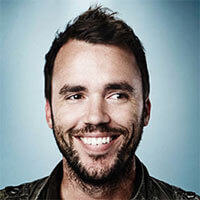At his core, Jeremy is an artist. Starting out as a painter first, Jeremy fell in love with the creative process. He then went on to study graphic design in college and founded his own graphic design company, Pixelgrazer, in 2001. Jeremy really only began taking pictures to bring texture into his design work. But before he knew it, he realized that photography was his true passion. So in April of 2005, Jeremy switched over to it full time and he has never looked back. In a relatively short amount of time, Jeremy earned the respect of artists, photographers, and celebrities alike. Now hailed as one of the trailblazers in the industry, Jeremy sees photography as a natural extension of his passion for the arts. Jeremy has taken portraits of many familiar names such as Taylor Swift, Tim Tebow, The Kardashians, Sting, Maggie Gyllenhaal, Heidi Klum, Gwyneth Paltrow, The Civil Wars, Emma Stone, Courtney Cox, and Ryan Seacrest, just to name a few. His clients, mostly entertainment based, include ABC, FOX, A&E, F/X, Discovery Channel, ESPN, People, US Weekly, VIBE, E!, Universal Records, Sony Records and Warner Brothers Records. His work has been published in Rolling Stone, ESPN Magazine, People Magazine, USA Today, Fast Company, NYTimes, TIME, Nylon and more. There's always something interesting going on in Jeremy's world. His humanitarian projects have been featured on CNN.com as international leading headlines twice, he shot the cover of Tim Tebow's NY Times best-selling autobiography, and he recently starred in an episode of The Real Housewives of Beverly Hills. In addition to all that, Jeremy is something of a social media/technology guru. He's a featured user on Google+ with over a million followers, he won the Celebrity TwitChange campaign last year that raised thousands of dollars to fight global poverty, and he's currently working on his first iPhone app to be released Summer 2012. Photography has taken Jeremy to six continents. He traveled with Britney Spears in 2009 as her "Circus World Tour" photographer, documented seventeen countries with the Passion World Tour in 2008, and has been on numerous trips to Africa and Haiti with various organizations. From all his travels, Jeremy has released 3 Photography books, "Hope in the Dark", "The Poor Will Be Glad" and "Awakening", and he's currently working on a 4th new book, "What's Your Mark?" with Zondervan Publishers due out Fall 2012.
Jeremy also spends his time on community projects, brainstorming innovative ways to use his camera to make an impact. In January 2010, after the devastating earthquake in Haiti, Jeremy responded with his "Voices of Haiti" photo essay, letting the people of Haiti write their own thoughts and prayers on found rubble. This project was displayed prominently at the entrance of a very important gathering of world leaders at the United Nations in March of 2010. They were meeting to discuss the rebuild of Haiti and they ended up pledging ten billion dollars to the effort. On that day, Jeremy's "Voices of Haiti" project proved that art can help change the world. In August of 2011, Jeremy traveled to Rwanda with filmmaker Laura Waters Hinson to document survivors and perpetrators of genocide who have reconciled and are living life together peacefully in the same community. Inspired by the "Voices of Haiti" photo essay, the portraits in this series captured genocide survivors standing with the killers of their families, who they've now forgiven. Many of the portraits were captured at the scene of the crime to help display the power of true forgiveness. The series ended up being featured on CNN.com as a worldwide leading headline on Monday, November 7th, 2011. Knowing the value that a photograph can have in just one person's life, Jeremy also founded
Help-Portrait, a worldwide movement of photographers using their time, equipment, and expertise to give back to those less fortunate. On December 12, 2009, the first world-wide Help-Portrait event provided free portraits for over 40,000 people in 42 Countries. Those numbers have increased significantly over the last 2 years, with 169,523 photos given to date in at least 56 countries. Help-Portrait continues to grow, encouraging all photographers to use their platform to make a difference with their cameras. Lastly, Jeremy's speaking and teaching career has taken off as he spends his time annually traveling around the country speaking at conferences like TEDx, Catalyst Conference, Photoshop World, WPPI, Google Plus Photographers Conference, Photo Plus Expo and many more. He has also hosted 2 of his own LifeFinder Tour's that have taken him all across the country. His LifeFinder Tour is based on his educational DVD, LifeFinder. Jeremy is also an instructor for Scott Kelby's "Kelby Training" and has released 3 classes on the Kelby Training website. Jeremy is a crock pot of ideas, always on low simmer. He doesn't sleep enough. His mind won't let him. Whether it's the next shoot, the next talk, the next book, the next app, or the next humanitarian project, Jeremy just doesn't stop. And that's why his career keeps moving forward. Bouncing back and forth between Nashville and LA, Jeremy draws a lot of inspiration from his amazing wife, Shannon, and their two ridiculously cute and utterly fantastic kids, Adler and Eisley. They also have a dog and a cat, but they are not as inspirational.
Source: jeremycowart.com
